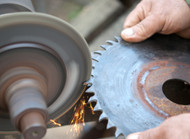Signs Your Circular Saw Blade Needs Sharpening (And How to Fix It)
Mar 16th 2025
Circular saws are at the very heart of woodworking and construction. With this being said, even the best tool is only as good as its blade. That’s why it's important to have your circular saw blade in good condition–which means sharp and rust-free in most cases.
On the other hand, oversharpening your blades can reduce their lifetime and distract from other possible issues. If you’re confused about when your circular saw blade needs sharpening, read on, because we’ve got it down to a T!
How To Tell if Your Circular Saw Blade Needs Sharpening
When you’ve worked with saw blades, you can tell by their condition if they need sharpening, restoration, or replacement. Here are some signs that indicate your Circular Saw Blade has become dull:
1. Increased Cutting Resistance
If you notice that pushing the material through the saw requires more effort than usual, it’s a clear indicator that the blade has dulled. A sharp blade should glide through the material with minimal force.
2. Rough or Burned Cuts
A sharp blade produces smooth, clean cuts. If your cuts appear rough, jagged or have burn marks, it suggests the blade is dull and generates excessive friction. This is also identified with a funny smell or visible smoke when cutting through materials like wood or plastic.
3. Excessive Noise and Vibration
Unusual sounds or increased vibration during operation can be signs of a circular saw blade requiring service. If the blade is no longer sharp, it can cause the material no heat up and deform the saw body, producing sub-par cuts and becoming a serious safety risk for the one using it.
4. Something Looks Wrong With The Blade
Examine the blade closely to see if it needs sharpening or not. Look for rounded or chipped teeth, resin buildup, or discoloration. These are signs that the blade isn’t in the best condition and could do with some treatment.
5. Material-Specific Indicators
Some signs of a dull blade are specific to the material you’re using it on. When cutting wood, a dull blade may begin to tearout. This change is a clear sign that the blade is pulling chunks of wood out rather than cutting cleanly.
Ways To Fix a Poorly Performing Saw Blade
Knowing if your blade is dull and in need of sharpening isn’t enough–you need to fix the problem if you plan on working with the blade again. Here are some ways to remedy a troublesomeblade:
-
Clean the Blade: Someof the time, when a blade begins to cut poorly, it is merely coated with resin, pitch, or debris. Cleaning it with solvents like oven spray, petroleum, paint thinner, or brake cleaner can remove these residues and potentially improve its efficiency.
-
Professional Sharpening: In many cases, the best option is to have a professional sharpening service tend to your blade. These services have specialized equipment and skilled professionals to ensure precise sharpening, which can extend the blade's lifespan and maintain optimal performance.
-
DIY Sharpening: If you possess the necessary skills and tools, it is possible sharpen blades at home. The teeth must be sharpened evenly so the blade cuts smoothly the next time you use it.
-
Replace the Blade: If the blade has missing or damaged teeth or if it has been sharpened multiple times and shows significant wear, replacement is the best option. Most blades have a lifespan, and when it's met, there isn’t any other option but to get a new one instead.
Reliable Blade Sharpening Services Near You
A dull blade doesn’t just mean messy work–it means more work since you’d need to put extra effort into achieving the usual precision and finish.
At The Sharpening House, we specialize in restoring your blades' sharpness, extending their lifespan, and improving their cutting efficiency.
Don't let dull blades hinder your projects—reach out to us today at (705) 325-8665 or visit our website to learn more. Experience the difference that expertly sharpened blades can make!

